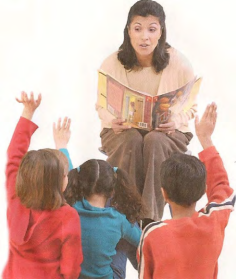 Attention Teachers: We want to share with you a 20-minute lesson that can reap significant rewards for your children’s success in reading! Reading aloud to children is an immensely powerful tool. It instills a love of reading as it simultaneously informs, explains, and entertains. Dialogic Reading is an effective way to read aloud to children as it incorporates activities for building the knowledge required for success in reading. It does this by creating a dialogue between the teacher and their student listeners during the reading of a book. Both teachers and parents can implement this technique. The method of Dialogic Reading was developed by Grover J. Whitehurst at the Stoney Brook Reading and Language Project in 2002 as a way to read to Preschoolers. The teacher reads aloud to their class and in response, the students become active participants in the Read-Aloud. The P.E.E.R. Strategy is an effective technique to stimulate Dialogic Reading. It facilitates the shared reading experience that you have with your students or that parents have with their child. As you read and ask questions, these steps will guide you in the process. Prompt the child to talk about the book. Evaluate what the child says. Expand on what the child says. Repeat the prompt. You may also want to keep in mind the following three levels of questioning and prompts: Level1: Identify something in the text or in the illustration: “What is ____? (people, place, thing) Level 2: Use a reading strategy: “What happened when _____? (cause and effect) Level 3: Use critical thinking: “What do you think________? These types of questions the Teacher or Parent asks with prompts should be ones that the children will ultimately learn to do themselves when they are reading by themselves. Ms. Johnson has referred to roughly twenty significant rewards for children who are ReadAloud using the PEER technique. The following examples are a small sample of these rewards:
With these above-mentioned rewards for children, selecting the right book should be a carefully thought out task by the adult. Since the children become the active participants, possible discussions can lead to what the characters are feeling. These feelings can therefore be used to help explain certain feelings to the children. The wordless book “Pancakes for Breakfast”, by Tomie de Paola was used to illustrate how to practice these strategies. Wordless books are beautifully illustrated books with no written text. The reader and listener ponder the illustrations carefully and invest in the story by becoming creative. They interpret the illustrations based on their experiences and their imagination. Our experience is that the ideas were as varied as the participants themselves. Can you imagine how excited children would be to create their own story? Some wordless books that both Ms. Johnson and participants have used with their children are listed here, as well as others contributed by participants: “The Arrival”, by Shan Tan “The Surprise”, by Sylvia Van Ommen “Good Night”, by Jan Ormer “Common Threads: Adam’s Day at the Market”, by Huda Essa “Tuesday”, by David Wiesner “City Mouse, Country Mouse”, by Maggie Rudy “The Red Sled”, by Lita Judge “What Is It Like to be a Fish”, by Wendy Pfeffer “The Cow Loves Cookies”, by Kaima Wilson “Oh, Baby! Amazing Baby Animals”, by Kris Hirschmann Every Teacher’s goal is to want children to love reading. “Children who have been read to dialogically are ahead in language development compared to children read aloud to in the traditional way. Dialogic reading is just children and adults having a conversation about a book.” (Grover J. Whitehurst, “Reading Rockets”) Reading aloud is a way to inspire children to become active readers and nurture life-long reading habits. The more engaged the children are in this process the more they will succeed. Let us know at the PDRC if you try the PEER technique and what your experience was. We would love to hear from you!
0 Comments
|
Archives
January 2024
Categories
All
|
